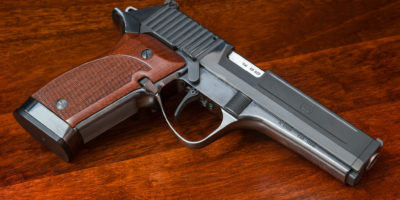Shootin’ n Snaggin’ with the Frugal Fisherman
When I was kid I used to go fishing regularly at a small, local pond with my babysitter Miss Grubbs. I could hardly contain the excitement each afternoon as she would hand me the hoe and an old coffee can and say “go dig us up some worms.”
I learned a ton about fishing and life from those outings with Miss Grubbs. Most everything she taught me still holds true today. Everything but how she handled the maintenance of her fishing reels. Whenever one of her reels would tighten up or act funny she would hold the rod by the tip and dip the entire reel and rod handle under water and hold it there for about 30 seconds. Once removed, she’d turn the reels handle a few times to work the water around and say “good as new.”
Well, not exactly. The reel would turn a little better for a short while but she’d have to dip it again eventually. Bless her heart, but what Miss Grubbs was actually doing was more damaging than good for those old school Daiwa and Zebco reels.
A fishing reel like most any mechanically inclined tool needs lubricants, not water, to ensure it works properly. A little oil or grease here and there and you’d be surprised how much better your reel retrieves.
But if you’re anything like me you have no clue where to start. You could refer to your owner’s manual. You know…that paperwork they give you when you made your initial rod and reel purchase. What? When? Exactly, those things are long gone.
You could try to go online and find a PDF version of the manual. If you can’t find the PDF you can use a more generalized maintenance outline found via a general Google search of your reel. If all else fails use some good old fashioned common sense and at the very least hit the areas you know could use a squirt of oil or two. Something’s better than nothing.
Different reels require different maintenance. Some professional grade baitcasting reels are so complicated and high tech you might want to consult a specialist. But for those do-it-yourselfers, you can use the outline below as a general guide for both a baitcasting and under spin reels. Follow all the relative steps for your model and at the very least you’ll get better performance and life out of your reel.
Spinning Reels (Under Spin)
-
Gather any necessary tools such as flat head or Phillips screwdrivers, as well as cotton swabs, a clean rag, isopropyl alcohol and oil / grease. Some new products I’ve fallen in love with lately are these molecular bonding greases and oils offered by today’s modern lubricant providers. These lubricants form a permanent bond to any metal they come in contact with and last as much as ten times longer than traditional lubricants. I recommend LBT’s Lightning Lube which comes in Reel Grease Power, Reel Power and High Speed Oil.
-
Remove the spool assembly by turning the drag adjustment knob counter clockwise. On reels equipped with a rear drag, spool assemblies likely release via a push button and handle assembly.
-
Inspect the spool assembly for damage. Pay special attention to the spool lip, as damaged or chipped spool lips will consequently cause premature wear on fishing line.
-
Clean the exterior of your reel with cotton swabs and isopropyl rubbing alcohol. Clean off any excess oil, grease, deposits or debris.
-
Inspect and clean the line roller assembly. Use a cotton swab to “feel” if the line roller bearing or bushing needs to be replaced. A rusted or worn bearing will be most noticeable during line retrieval.
-
Lightly oil the line roller assembly. Regular oiling (after every fishing trip or two) will greatly increase the life expectancy of the line roller bearing.
-
Oil the drive gear bearing(s). Bearings are visible with the handle removed. Some reels also have an additional drive gear bearing on the right hand side opposite the handle close to the reel‘s body. Make sure to lube both left and right drive gear bearings.
-
On reels that are equipped with maintenance port apply one or two drops of oil. Do not use a degreaser such as WD40; it will cause premature wear and tear on the internal parts of your reel.
-
Oil the bail arm assembly to maintain smooth and consistent bail operation.
-
As I stated prior each spinning reel has its own lubricating needs. As a general rule lubricate anything that moves. Following that rule alone should help immensely.
Baitcasting Reels
Baitcasting reels are far more complicated than spinning. They have many more moving parts. If you aren’t completely confident in your mechanical skills I highly recommend you allow a specialist to maintenance your baitcaster.
-
Once again gather any necessary tools such as screwdrivers and a general wrench set, cleaning supplies and oil / grease. As stated prior I highly recommend LBT’s Lightning Lube which comes in Reel Grease Power, Reel Power and High Speed Oil.
-
For most reels, you can access the spool assembly via the turnkey dial located opposite the handle. Remove the spool assembly. Clean any visible dirt and debris from the exterior of reel using a cotton swab and isopropyl rubbing alcohol.
-
Clean the inside of the pinion gear with a cotton swab for optimal freespool and casting performance.
-
Clean and oil each brake collar to maintain quiet, efficient casting. Replace the brake collars if any appear worn or excessively dirty.
-
Inspect and clean the spool assembly. Clean the spool shaft and oil spool bearing or bushing if applicable. Do not grease the spool shaft, as it will cause the reel’s freespooling to become slowed and clogged.
-
Clean and oil the brake case and spool bearing, lightly oil the support bearing and drive shaft bearing, and clean and oil the levelwind system.
-
Remove the handle assembly and the handle nut below the assembly.
-
Remove the star drag, spring and washers. It’s a good idea to use an old egg crate to keep each of the numerous parts separate and organized.
-
Remove the side plate screws and side plate, making sure to not loose the yoke springs which can fall out very easily.
-
Remove the drive gear, drag washers, pinion gear, yoke, yoke springs, drag spacer and drag plate.
-
Clean and grease each of the teeth on the drive gear, clean away any old grease on the drag washer and reapply grease, and clean the inside of the pinion gear.
-
Reinstall the drive gear, drag washers, yoke, yoke springs, drag spacer and drag plate. As well as the side plate, side plate screws, star drag, washers and handle assembly.
-
Lastly, oil the line guide bar.
Your baitcaster should be ready to go at this point.
Now that you’ve lubricated and readied your reels for another successful fishing season, it’s time to reline each reel. Here’s a great knot making relining a snap. It’s called the arbor knot and is hands down the easiest knot to learn to tie.
Basically, pass your line around the spool making sure to pull out about six to eight inches of extra line. Tie an overhand knot around the incoming line opposite the other side of the spool. Then tie another overhand knot at the end of the line. Pull tight and reel away. Make sure you don’t overfill the spool. Overfilling will cause the reel to tangle and will drastically decrease casting distance.
I hope the above can get another year out of your reels and ensure that when you’re on the water the least of your worries will be your equipment. Now all we need is some sunny weather and a day off to spend on the water.
If you have any questions, concerns or advice please contact me at frugalfisherman1@gmail.com.







Leave a Reply